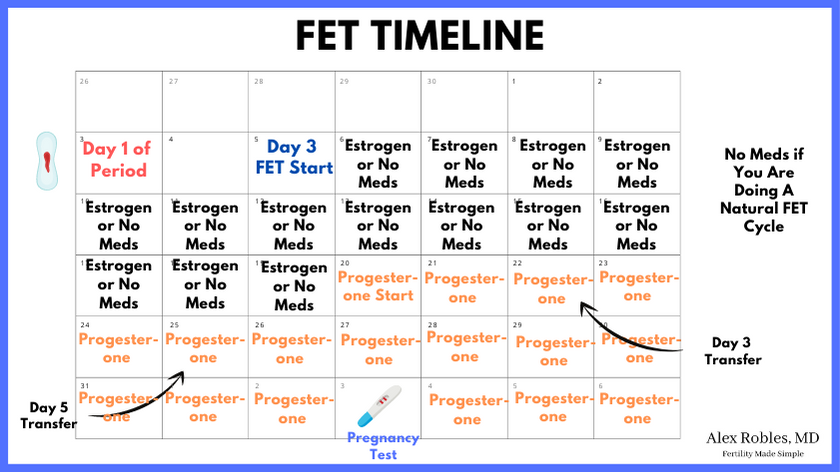Are you having a mock embryo transfer?
If so, you may be wondering what this procedure involves and why it is necessary for the IVF process.
In this article, you will learn:
- What is a mock transfer?
- How does it work, and why is it done?
- What day in your cycle do you do it?
Let’s get started.

What is a mock embryo transfer?
A mock transfer is a procedure in which we do a “trial run” of your upcoming embryo transfer.
This practice run helps us check the position of your uterus and cervical canal to determine if there will be any potential challenges with the real transfer.
It is better to know in advance if you are a difficult transfer so that we can prepare accordingly.
When is a mock transfer done?
A mock embryo transfer can take place at many different time points:
- During the egg retrieval (while you are under anesthesia)
- During a hysteroscopy, saline infusion sonogram, or hysterosalpingogram
- Before the start of your IVF cycle, during a routine ultrasound visit
- Minutes before your actual transfer
- During a mock embryo transfer cycle
In a mock embryo transfer cycle, we take a uterine lining biopsy for a test called the Endometrial Receptivity Assay (ERA).
More on that later.
What can I expect on the day of the mock transfer?
On the day of the mock transfer, we will ask you to come in with a full bladder.
A full bladder helps visualize your uterus on ultrasound and helps push your uterus in a favorable direction for the transfer.
Once you are set up, the fertility doctor will place a speculum into your vagina to visualize your cervix, much like a pap smear.
A soft catheter is then passed through your cervix and into the uterus.
The doctor will use transabdominal ultrasound guidance to help see that the catheter is in the ideal location in your uterine cavity.
The entire process may only take 15 minutes.
Is it painful?
The mock transfer is not painful, but it is uncomfortable. You may feel some cramping when the catheter enters your cervix, but many patients tolerate it well.
Some fertility clinics recommend taking a mild pain reliever such as Ibuprofen or Tylenol before the procedure to help with any cramping (uterine contractions) you may experience.
How uncomfortable is a mock embryo transfer vs saline sonogram?
A mock embryo transfer is generally less uncomfortable than a saline sonogram.
A mock transfer only requires the placement of a thin catheter through the cervix. In contrast, a saline sonogram requires the placement of a larger catheter and the infusion of fluid into the uterine cavity.
Is anesthesia required for a mock transfer?
No, anesthesia is not required for a mock transfer.
However, if you are having a mock transfer during an egg retrieval procedure, you will be given anesthesia for the egg retrieval and have the mock transfer while you are still asleep.
Are there any side effects or risks?
You will likely experience cramping after the procedure, but it should be mild and resolve within a few hours.
If you are doing a medicated mock cycle, you might experience some side effects from the medication such as bloating, breast tenderness, or headaches. These symptoms tend to be mild.
However, if you experience severe pain, fever, or heavy bleeding, please contact your fertility clinic urgently.
Is bleeding after a mock transfer normal?
Spotting or light bleeding after a mock embryo transfer is normal as the catheter may disrupt your endometrial lining.
Please contact your fertility clinic if you experience heavy bleeding or soaking a pad within an hour.
How should you prepare for a mock embryo transfer?
The best way to prepare for a mock transfer is to follow the instructions provided by your fertility clinic.
Typically, you need to ensure that your bladder is full, as this will help the ultrasound visualization and may help with the passage of the catheter into your cervix.
The ultrasound also lets us see where the fundus (or the top) of your uterus is so that we don’t place the catheter too far.
What are the downsides of a mock transfer?
The main downside of a mock transfer is that it doesn’t always mimic what will happen during your actual embryo transfer.
For example, your uterine position may be different on the day of the real thing.
This is especially true if your mock transfer is done after a retrieval or a random time in your cycle that doesn’t coincide with when a transfer would occur.
In these cases, it is difficult to know whether a mock transfer will help the actual procedure go smoother.
Other Related Questions
What exactly is a mock cycle?
A mock cycle is a unique treatment cycle in which you undergo all the steps of a frozen embryo transfer cycle (FET cycle), but instead of having an embryo transferred, we take a biopsy of the uterine lining.
First, you will come to the office on cycle day 2 or 3 of your menstrual cycle to have a baseline ultrasound and blood work.
You will then start the mock transfer cycle the same way as a standard FET. I.e., you will have periodic ultrasounds to measure the thickness of your uterine lining and blood work to assess your hormone levels.
How long does a mock cycle take?
A mock cycle typically lasts approximately 18-20 days or a little over two weeks, starting on the first day of your period. The mock cycle timeline is the same as a frozen embryo transfer cycle.
What cycle day is a mock transfer done?
A mock embryo transfer typically takes place on the day you would have a scheduled embryo transfer, usually around cycle day 18-20.
Here is what a typical cycle might look like:
- Day 1: The first day of your menstrual cycle
- Days 2-3: Baseline ultrasound at the office with bloodwork (start of estrogen medication if you are doing a medicated mock cycle)
- Days 4-12: Ultrasounds every 3-5 days with blood tests to monitor the thickness of your lining
- Day 13-14: Trigger shot for ovulation and egg maturation (only if you are doing a natural cycle)
- Day 14-15: Start of Progesterone medication
- Day of Progesterone Start+5 Days: The Mock Transfer
Here is a calendar of what a typical FET might look like.

Why is a biopsy performed with a mock transfer?
The ERA biopsy is a test that may help determine if your uterine lining is receptive or ready for the implantation of an embryo. Depending on the results, the test may recommend that we alter the timing of the real embryo transfer.
The ERA is supposed to help diagnose why you may have had prior implantation failures.
However, it is unclear if the ERA biopsy improves pregnancy success rates, as there is conflicting evidence on its effectiveness. A recent randomized controlled trial of 767 patients who underwent embryo transfer with or without the recommended ERA timing showed no difference in ongoing pregnancy rates.
Also, insurance may not cover the test costs.
How much is a mock transfer for IVF?
The price of a mock transfer depends on the context in which it is performed.
A mock transfer that is part of a medicated IVF cycle will cost a lot more than if the transfer is done together with another procedure.
The price may be upwards of $1000 if you have a mock transfer as part of an ERA test.
Conclusion
The mock ET will help us determine:
- uterine position,
- uterine size (length of the uterine cavity),
- the anatomy of the endocervical canal (i.e, the direction of the uterine cavity)
- the best route for entering the uterus,
- the best type of embryo transfer catheter to use, and
- if we need to use a different transfer technique on the day of the actual transfer.
With that said, not every fertility specialist utilizes a mock ET. Be sure to speak with your doctor if you believe you might be a difficult embryo transfer.
Continue learning about the next steps in the in vitro fertilization process with the following posts.
- The Fresh Embryo Transfer (Timeline, Tips, & Success Rates)
- What To Expect On The Day Of The Embryo Transfer
- When To Check A Pregnancy Test After Embryo Implantation
Make An Appointment With Dr. Robles To Discuss Your Fertility Options Today!

Alex Robles, MD
Dr. Alex Robles is a Spanish-speaking Latino-American Reproductive Endocrinologist and Infertility specialist in New York City, and a board-certified OBGYN. He has a special interest in health, lifestyle, & nutrition. Make an appointment with Dr. Robles to discuss your fertility options today!
References:
- Katariya KO, Bates GW, Robinson RD, Arthur NJ, Propst AM. Does the timing of mock embryo transfer affect in vitro fertilization implantation and pregnancy rates?. Fertil Steril. 2007;88(5):1462-1464. doi:10.1016/j.fertnstert.2006.12.05
- Henne MB, Milki AA. Uterine position at real embryo transfer compared with mock embryo transfer. Hum Reprod. 2004;19(3):570-572. doi:10.1093/humrep/deh116
- Borkar A, Shah A, Gudi A, Homburg R. Outcome of mock embryo transfer before the first IVF cycle: A randomized control trial. Int J Reprod Biomed. 2020;18(11):951-960. Published 2020 Nov 22. doi:10.18502/ijrm.v13i11.7962
